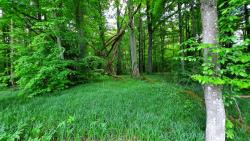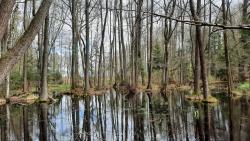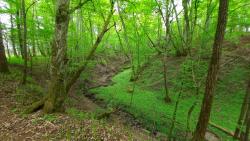 Asset Publisher
Asset Publisher
Polish forests
Poland is in the European lead, while concerning the area of all forests. They cover about 29,2 % of the country territory, and grow within the area of 9,1 million hectares. The overwhelming majority of the forests is state owned, of which almost 7,6 million hectares are managed by the State Forests National Forest Holding..
The number of Polish forest is still growing. The forestation rate of the country has increased from 21 % in 1945 to 29,2 % at the moment. Between 1995 and 2008, the forest area increased by 310 thousand ha. The basis for afforestation works is the "National Programme for Increasing the Forest Cover" (KPZL), assuming an increase of the forestation rate up to 30 % by 2020 and up to 33 % by 2050. Polish forests abound in flora, fauna and fungi. 65 % of the total number of animal species live there.
The forests grow in our country on poor soils, mainly because of the development of the agriculture in previous years. It influences the distribution of the types of the forest sites in Poland. Over 55 % of the forest areas is covered with coniferous forests. In other areas, there are forest sites, mainly the mixed ones. Their small part constitute alder and riparian forests – not more than 3 %.
In the years 1945 – 2011 the area of natural deciduous tree stands within the area of the State Forests National Forest Holding increased from 13 to 28,2 %.
Within the lowlands and uplands the most often occurring tee species is pine. It covers 64,3 % of the forest area of the State Forests National Forest Holding and 57,7 % of private and commune forests. In the mountains the predominant species is European spruce ( in the west) and European spruce with beech (in the east). Domination of pine is the result of carrying on sustainable forest management in the past. Once, the monocultures (crops or cultivations of one species) were the answer to the great demand of industry for wood. Such forests appeared to be quite fragile to climatic factors. They also were often the prey of pests' expansion.
In Polish forests, the share of other tree species, especially deciduous trees have been systematically increasing. The foresters have stepped aside from monocultures – that is why, they try to fit specific species of the forest stand to the natural stand, that would be proper for the given area. Thanks to that, in the years 1945 – 2011, the area of the deciduous tree stands within the lands of the State Forests National Forest Holding increased from 13 to 28,2 %. There occur more and more frequently the following tree species: oaks, ashes, maples, sycamore maples, elms, but also birches, beeches, alders, poplars, hornbeams, aspens, tilias and willows.
Our forests are the most often represented by the forest stands aged 40 to 80 years. The average age of the forest equals 60 years. More and more trees are of big size at the age over 80 years. Since the end of the Second World War, the forests' area has increased up to almost 1,85 million hectares.
Raport o stanie lasów w Polsce 2012
 Asset Publisher
Asset Publisher
 Asset Publisher
Asset Publisher
Lasy nadleśnictwa
Lasy nadleśnictwa
Powierzchnia ogólna Nadleśnictwa Mrągowo wynosi 19 964 ha, w tym drzewostany zajmują 18 664 ha. Lesistość terenu wynosi średnio 24,3%, największa jest na terenie gminy Piecki, gdzie wynosi 53,8 %. Nadleśnictwo składa się z trzech obrębów: Gązwa, Sadłowo i Mrągowo. Mamy tu prawie wszystkie siedliska z występujących na terenie RDLP Olsztyn oraz większość rodzimych gatunków drzew (z czego sosna zajmuje 41% powierzchni, świerk – 16%, brzoza – 19%).
Lasy Nadleśnictwa Mrągowo stanowią 218 kompleksów leśnych. Tworzą one generalnie zwarte kompleksy. Większość lasów skupiona jest w 3 kompleksach leśnych powyżej 2000 ha stanowiących ogółem 62 % jego powierzchni. Lasy prywatne występują przeważnie w dużym rozproszeniu i na niewielkich obszarach. Często przylegają do lasów nadleśnictwa, ale rzadko stanowią wśród nich enklawy.
Cechą charakterystyczną Pojezierza Mrągowskiego jest występowanie szeregu południkowo układających się rynien, w obrębie których często występują jeziora. Dział wodny Wisły i Pregoły przebiega w ten sposób, że wody z zachodnich rynien kierują się na południe do Narwi, ze wschodu zaś do Łyny. Wzdłuż rynien ciągną się wały ozów i kemów, ale na wysoczyznach między rynnami występuje glina morenowa. Wzniesienia nad poziom morza wahają się w granicach 130 - 170m. Budowa geomorfologiczna jest bardzo zróżnicowana, z bogata siecią rzek, pradolin, bruzd rynnowych z licznymi jeziorami. Tutejszy krajobraz cechują względne różnice wysokości dochodzące w strefie moreny czołowej do 20-30 m, przez co krajobraz urozmaicony jest licznymi wzniesieniami z jarami i wąwozami.
Z budową geologiczną wiąże się występowanie określonych typów gleb. Od żyzności gleb zależy bogactwo i różnorodność życia roślinnego. Gleby Nadleśnictwa Mrągowo zostały wytworzone z utworów ostatniego zlodowacenia bałtyckiego. Znaczna cześć nadleśnictwa położona jest na równinie sandrowej oraz częściowo na wysoczyźnie polodowcowej zbudowanej głównie z utworów moren dennych i czołowych fazy pomorskiej. W obrębach Gązwa i Sadłowo największy udział maja żyźniejsze gleby płowe, gdzie dominującym substratem jest tutaj glina zwałowa. W tej części nadleśnictwa dominują siedliska lasowe, z większym udziałem gatunków drzew liściastych: buka, dębu, brzozy, graba, olchy, jesiona i klonu. W obrębie Mrągowo największy udział mają uboższe gleby bielicowo –rdzawe i gleby brunatno – rdzawe, przez co dominują tu siedliska borowe, gdzie występują głównie drzewa iglaste: sosna i świerk.
W lasach nadleśnictwa Mrągowo występuje wiele gatunków roślin i zwierząt podlegających różnym formom ochrony przyrody. Spośród roślin objętych ochroną gatunkową występują tu: lilia złotogłów, zawilec wielkokwiatowy, wawrzynek wilczełyko, podkolan biały, bluszcz pospolity, rosiczka, różne gatunki storczyków, pióropusznik strusi. Wśród zwierząt występujących na terenie nadleśnictwa występują gatunki łowne: łosie, jelenie, sarny, dziki, zające, lisy, jenoty, borsuki, kuny, norki. Ze zwierząt chronionych spotkać tu można wilki, rysie, bobry, wydry. Dobre warunki bytowania znalazły tu również ptaki chronione objęte ochroną strefową, takie jak: orliki krzykliwe, bieliki, bociany czarne i kanie: czarna i ruda. Wśród innych gatunków objętych ochroną ciekawostką jest występowanie pojedynczych stanowisk żółwia błotnego.


 fot. Paweł Fabijański
fot. Paweł Fabijański
 fot. Paweł Fabijański
fot. Paweł Fabijański
 fot. Paweł Fabijański
fot. Paweł Fabijański




